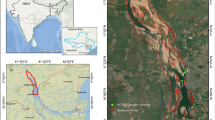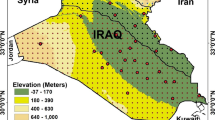Abstract
The Qinghai Lake is the largest inland lake in China. The significant difference of dielectric properties between water and ice suggests that a simple method of monitoring the Qinghai lake freeze-up and break-up dates using satellite passive microwave remote sensing data could be used. The freeze-up and break-up dates from the Qinghai Lake hydrological station and the MODIS L1B reflectance data were used to validate the passive microwave remote sensing results. The validation shows that passive microwave remote sensing data can accurately monitor the lake ice. Some uncertainty comes mainly from the revisit frequency of satellite overpass. The data from 1978 to 2006 show that lake ice duration is reduced by about 14–15 days. The freeze-up dates are about 4 days later and break-up dates about 10 days earlier. The regression analyses show that, at the 0.05 significance level, the correlations are 0.83, 0.66 and 0.89 between monthly mean air temperature (MMAT) and lake ice duration days, freeze-up dates, break-up dates, respectively. Therefore, inter-annual variations of the Qinghai Lake ice duration days can significantly reflect the regional climate variation.
Similar content being viewed by others
References
Palecki M A, Barry R G. Freeze up and break up of lakes as an index of temperature changes during the transition seasons: A case study for Finland. J Appl Meteor, 1986, 25: 893–902
Schindler D W, Beaty K G, Fee E J, et al. Effects of climatic warming on lakes of the central boreal forest. Science, 1990, 250: 967–970
Robertson D M, Ragotzkie R A, Magnuson J J. Lake ice records used to detect historical and future climatic changes. Clim Change, 1992, 21: 407–427
Walsh S E, Vavrus S J, Foley J A, et al. Global patterns of lake ice phenology and climate: Model simulations and observations. J Geophys Res, 1998, 103: 28825–28837
Magnuson J J, Roberston D M, Benson B J, et al. Historical trends in lake and river ice cover in the Northern Hemisphere. Science, 2000, 289: 1743–1746
Duguay C R, Pultz T J, Lafleur P M, et al. RADARSAT backscatter characteristics of ice growing on shallow sub-Arctic lakes, Churchill, Manitoba, Canada. Hydrol Proc, 2002, 16: 1631–1644
Todd M C, Mackay A W. Large scale climatic controls on Lake Baikal ice cover. J Clim, 2003, 16: 3186–3199
Weyhenmeyer G A, Meili M, Livingstone D M. Nonlinear temperature response of lake ice breakup. Geophys Res Lett, 31: L07203, doi:10.1029/2004GL019530
Johnson S L, Stefan H G. Indicators of climate warming in Minnesota: Lake ICE covers and snowmelt runoff. Clim Change, 2006, 75:421–453
Hall D K, Riggs G A, Salomonson V V, et al. MODIS snow-cover products. Remote Sens Environ, 2002, 83: 181–194
Pietroniro A, Leconte R. A review of Canadian remote sensing and hydrology, 1999–2003. Hydrol Proc, 2005, 19: 285–301
Walker A E, Davey M R. Observation of Great Slave Lake ice freeze-up and break-up processes using passive microwave satellite data. In: Proceedings of the 16th Canadian Remote Sensing Symposium, Sherbrooke, Quebec, Canada, 1993. 233–238
Ulaby F T, Moore R K, Fung A K. Microwave Remote Sensing: Ac- tive and Passive. Volume III: from Theory to Applications. Norwood, MA: Artech House, 1986. 1065–2162
Kendra J R, Sarabandi K, Ulaby F T. Radar measurements of snow: experiment and analysis, IEEE Trans Geosci Remote Sens, 1998, 36:864–879
Author information
Authors and Affiliations
Corresponding author
Additional information
Supported by National Basic Research Program of China (Grand No. 2007CB411506), and National Natural Science Foundation of China (Grand Nos. 40601065 and 40701030)
About this article
Cite this article
Che, T., Li, X. & Jin, R. Monitoring the frozen duration of Qinghai Lake using satellite passive microwave remote sensing low frequency data. Chin. Sci. Bull. 54, 2294–2299 (2009). https://doi.org/10.1007/s11434-009-0044-3
Received:
Accepted:
Published:
Issue Date:
DOI: https://doi.org/10.1007/s11434-009-0044-3




